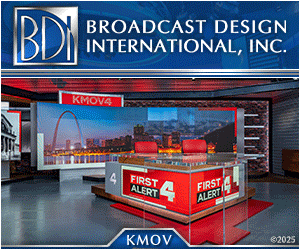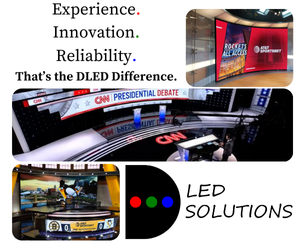Industry Insights: Key considerations for selecting studio lighting equipment

Subscribe to NewscastStudio for the latest news, project case studies and product announcements in broadcast technology, creative design and engineering delivered to your inbox.
In this edition of Industry Insights, broadcast lighting suppliers discuss how advancements in lighting technology have shaped modern studio environments.
The roundtable covers the significant impact of LED technology on energy efficiency, color control and heat management, as well as the challenges of achieving consistent color temperatures across multiple fixtures.
Participants explore key factors to consider when selecting studio lighting equipment, from client needs and budget constraints to technical requirements like grid height and lighting flexibility. They also delve into the role of lighting control systems and emerging trends in soft lighting for improving talent appearance and studio workflows.
Key takeaways from the Industry Insights roundtable
- LED technology has improved energy efficiency, reduced operational costs, and provided more control for lighting designers.
- Selecting the right studio lighting requires understanding the production needs, studio dimensions, and budget considerations.
- Achieving consistent color temperature across multiple fixtures is crucial and can be addressed through advanced calibration and color control technologies.
- Integration of IP-based lighting control systems enhances efficiency by allowing remote troubleshooting and system management.
- Soft lighting trends, such as LED panels and diffusers, offer more flattering and natural lighting for on-camera talent, enhancing their visual appearance.
How has LED technology changed the broadcast lighting landscape?
Tim S. Kang, principal engineer for imaging applications, Aputure: The broadcast landscape has held on to incandescent lighting for many good reasons, but LED technology has finally reached the scientific, technological, and economical point where it can be seen as a true replacement. It has lowered direct and indirect power consumption due to lower heating bills, and has provided lighting designers more control and flexibility than previously imagined.
Kevin Lu, product manager, Ikan: LED technology has revolutionized broadcast lighting primarily through energy efficiency, color quality, constant color control, and heat management. LEDs consume less power and last longer, reducing operational costs. They offer better color rendering and precise control, essential for consistent lighting. Additionally, they produce less heat, which enhances comfort and protects equipment.
What are the key factors to consider when choosing lighting instruments for a studio?
Paul Flemming, manager of design and engineering, ARRI: It starts by understanding the client’s needs and requirements for the studio: what types of content will be produced, how flexible does the overall environment need to be to accommodate, how many technical staff will be operating the studio during productions, and of course, what is the overall budget. From there, we can ascertain the overall infrastructure, and therefore consult on the optimal lighting solutions that would bring maximum benefits and efficiency.
Sam Cercone, cofounder, Brightline Lighting: The primary considerations when selecting fixtures for a studio are the dimensions of the studio, its grid height, and the type and size of the set. While the studio grid height is a determining factor in how powerful the fixtures need to be, the optimal lighting design for a physical hard set will differ from that of a virtual set. To achieve today’s popular look of large, uncluttered set with no visible light fixtures within the camera frame, fixtures with a long- throw distance should be used.
Glen Harn, president, PrimeTime Lighting Systems: We recommend consideration of multiple factors. Where or what is being lit — newscasts or interviews? Is it a streaming video podcast or a weather set? Quality and longevity: How long are the lights expected to last? Are the lights being considered dead quiet and trouble free? What are the index numbers/quality of light output?
Tim S. Kang: Lighting designers should consider higher spectral fidelity, seamless connectivity and lighting console control capabilities, high output efficiency to reduce power consumption for the same desired levels of light output, and smooth and extremely low dimming capability for fades and cues.
How has the integration of lighting control systems enhanced efficiency and creativity in studio lighting?
Paul Flemming: The development of IP-based lighting networks enables smooth integration alongside other AV systems for a more effective studio environment. Studio engineers can not only apply the same workflows they are accustomed to from other specializations but also have remote access to all devices for more efficient troubleshooting and maintenance.
What are the latest advancements in color rendering index (CRI) and color temperature control in studio lights?
Brian Doran, product specialist for lighting, ARRI: We are finally starting to see LED fixtures with CRI scores up to 99. What’s even better — we are seeing the adoption of more rigorous and detailed color measurement systems, such as TM30.
Sam Cercone: Quality LEDs have advanced to a near-perfect spectral distribution. The CRI rating of many of today’s studio fixtures can exceed 97/98.
Tim S. Kang: CRI does not suffice to indicate color quality in an LED light. Two metrics now matter: the spectral similarity index (SSI) scores the identity match of a light, and TM-30 provides a useful color vector graphic (CVG) hue and saturation chart to indicate the potential color shifts from a light. Studio lights meant for white light applications now have the ability to output both color temperature and tint (also known as plus and minus green).
Kevin Lu: Recent advancements in studio lights include LEDs with CRI values of 97+ for accurate color reproduction and fixtures that allow precise color temperature adjustments from 2,700K to 6,500K. Color temperature also stays consistent across different intensity levels.
What role does energy efficiency play in the selection of studio lighting equipment?
Kevin Lu: Energy efficiency is vital in selecting studio lighting equipment because it reduces electricity costs, aligns with sustainability goals, and lowers heat output, decreasing cooling needs. Additionally, energy-efficient lights have a longer lifespan, cutting down on maintenance of changing out bulbs and replacement costs of increasingly scare bulb supply.
What are the challenges and solutions for achieving consistent color temperature across multiple studio lights?
Brian Doran: Manufacturers have to ensure that the lights we produce today will match the ones we produce in five years. Not just within a single product line, but across our entire portfolio. Investing in proper calibration and thermal management is key to maintaining color consistency.
Sam Cercone: Single color LED fixtures may require color correction with various gels applied to the fixture. A gel correction approach can be cumbersome and time-consuming. Ideally fixtures that have adjustable CCT (correlated color temperature) from “tungsten” 3200K to “daylight” 5600K make the job of consistency much easier and far more accurate.
Tim S. Kang: LED manufacturers often don’t use the same spectral definitions for their light fixtures, and don’t always calibrate their fixtures to international standards. Lighting designers must use a spectrometer like the Sekonic C800, not legacy colorimeters, and a live camera feed to accurately assess the color temperature consistency between different lights.
Kevin Lu: Achieving consistent color temperature across multiple studio lights can be challenging due to variations in light output, aging bulbs, and different fixtures. Solutions include using the same brand and model of fixtures, using color correction gels, and using lights that are variable color temperature so you have the flexibility of adjusting the color temperature of the light.
What are the latest trends in soft lighting and their impact on talent appearance?
Glen Harn: We strive to make our talent look great. Our MSLED 40 Soft Lights are 52 inches wide. Some Lighting Directors have taken to using them almost end-to-end in a semi-circle around a newsdesk. The lighting results are absolutely gorgeous.
Kevin Lu: The latest trends in soft lighting include the use of LED panels and diffusers, which provide a more even and flattering light. Soft lighting reduces harsh shadows and highlights, creating a more natural and appealing appearance for on-camera talent. This trend enhances skin tones and overall visual quality, making talent look their best. Also it’s much easier on the talents eyes.
What are the latest innovations in lighting fixtures for specific applications like news, sports, and entertainment?
Glen Harn: Our new Niagara Cyc Wall Lights are innovative instruments for cyc walls and green screens. The Niagaras can be spaced 10-12 feet apart for an even wash top to bottom and side to side. They keep the light on the wall allowing talent to be lit separately.
What are the emerging trends in lighting control protocols and their impact on studio workflows?
Tim S. Kang: Ethernet versions of lighting protocols like sACN have enabled studios to use ethernet networking hardware, instead of DMX cabling, to control their lighting setups. This protocol has enabled remote control from any part of the world.
How do lighting designers incorporate sustainability into studio lighting practices?
Glen Harn: We find that companies that incorporate a sustainable strategy find our 5-year warranty and passive cooled lights beneficial. Without fans, our lights use less energy. Many studios must replace lights because fans go out and lights just aren’t built to last. We build our lights for heavy commercial use and they last well beyond the warranty without any problems.
What are the future trends in studio lighting technology that will shape the industry?
Tim S. Kang: Higher spectral fidelity with fully tunable shades of white light will keep growing more accessible in lighting fixtures. Additionally, Image Based Lighting has allowed for more natural and intuitive control of lighting technology to match on-screen graphics.
What are the biggest questions or concerns you’re hearing today from end users?
Brian Doran: Increasingly, end users are telling us that budgets are tight, but of course, live television still demands the most reliable equipment. It’s more important than ever to offer premium quality at a competitive price.
Glen Harn: End users are concerned about a combination of high-quality light output and trouble-free performance. Too often, studios compromise quality to find a lower-cost solution to their lighting challenges. And too often they end up regretting it. I could talk all day about the horror stories I’ve heard from attempts to save by sacrificing quality.
What is the current lifespan expectation from an end user?
Glen Harn: We approach every decision that goes into designing and engineering our lights with the determination that it should be running as good as new twenty years from now. We just don’t think in terms of planned obsolescence.
Kevin Lu: Typically expect LED light fixtures to last between 25,000 and 50,000 hours, which translates to approximately 10 to 20 years based on typical usage. This extended lifespan reduces the frequency of replacements and makes LEDs a cost-effective choice in the long run.
Subscribe to NewscastStudio for the latest news, project case studies and product announcements in broadcast technology, creative design and engineering delivered to your inbox.






tags
Aputure, ARRI, Brian Doran, Brightline, Glen Harn, Ikan, Kevin Lu, LED light, Paul Flemming, PrimeTime Lighting, Sam Cercone, Tim Kang
categories
Broadcast Lighting Design, Heroes, Industry Insights, Lighting and Lighting Design, Voices